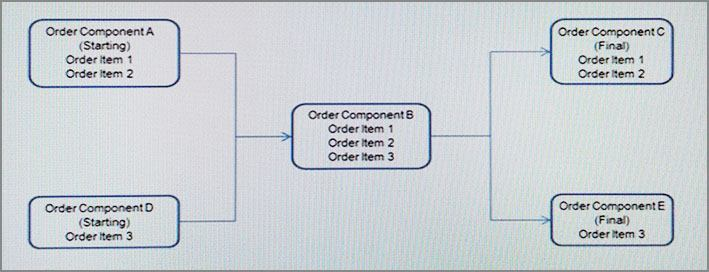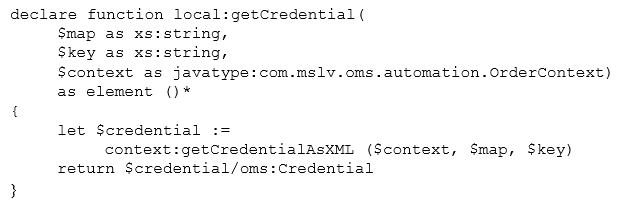File Info
| Exam | Oracle Communications Order and Service Management Server 7 Implementation Essentials |
| Number | 1z0-493 |
| File Name | Oracle.1z0-493.CertDumps.2017-12-17.89q.vcex |
| Size | 1 MB |
| Posted | Dec 17, 2017 |
| Download | Oracle.1z0-493.CertDumps.2017-12-17.89q.vcex |
How to open VCEX & EXAM Files?
Files with VCEX & EXAM extensions can be opened by ProfExam Simulator.
Coupon: MASTEREXAM
With discount: 20%





Demo Questions
Question 1

Consider an order recognition rule where the validation rule XQuery expression contains the following lines of code. When a CRM application tries to create orders that would be processed by this recognition rule by using the CreateOrder web service, which are two possible responses it could receive depending on the output of the validation expression?

- a “CreateOrderResponse” message with the created “Order Id”
- a “Fault” message with the description containing “No matching Order Recognition rule found”
- a “Fault” message with a description containing “Order Id is missing in the request”
- a “Fault” message with a description containing “Transaction not allowed”
- a “Fault” message with the description containing “Error in validation expression. See order for details”
Correct answer: BC
Question 2

OSM is executing an order with the process indicated in the diagram. Immediately after the completion of TaskD, a revision is received, which causes only TaskB to be re-evaluated. During the re-execution of TaskB, a significant data element used by TaskA and TaskD is updated in the order. Which task is re-evaluated when the compensation for TaskB completes?

- TaskA
- TaskB
- TaskC
- TaskD
- TaskE
Correct answer: D
Question 3
What is the key significance of componentKey in the following ControlData structure?
ControlData/Functions/Order_Component_Name/componentKey
- to uniquely identify an instance of an order component at run time
- to calculate the processing granularity that generates the componentKey for a function or target system
- to store the granularity of the function that is identified by Order_Component_Name
- to indicate the function name, target system name, and granularity name of an order component
- to store any key generated during the execution of an order component that is identified by Order_Component_Name
Correct answer: B
Explanation:
Reference: https://docs.oracle.com/cd/E49311_01/doc.724/e41610/dscom_ocomp_ctrl_data_man.htm#DSCOM164 Reference: https://docs.oracle.com/cd/E49311_01/doc.724/e41610/dscom_ocomp_ctrl_data_man.htm#DSCOM164
Question 4

This diagram represents the orchestration plan of an order that you submitted on January 1. The following are configured in your cartridge:
- Each order component has a minimum processing duration of two days.
- The product specification of Order Item 3 has a minimum processing duration of four days.
- In the product specification of Order Item 3, Order Component B has a duration of four days.
Considering that the requested delivery date is set to January 10 for all order items, when will the order start its execution?

- January 1
- January 2
- January 4
- January 6
- January 8
- January 10
Correct answer: A
Question 5

The following function is called in an XQuery automation plug-in before performing a logic that you have developed. Identify the functional action that would be executed with the output of this code.

- Authenticate with a southbound interface.
- Receive responses from a JMS queue.
- Publish messages to a JMS queue.
- Communicate with another running order in the same OSM instance.
- Check the users that are running tasks in the current order.
Correct answer: D
Question 6
Identify three functions of the OSM Task Web client.
- It enables order processing personnel to monitor and manage tasks within an order and to ensure that all associated tasks are completed.
- It enables order fallout managers to diagnose and manage the order fallouts associated with an order.
- It enables users to associate roles or workgroups with task and manually complete the activities associated with those tasks.
- It enables users to monitor email notifications and handle them through acknowledgement, escalation, and forwarding to other users.
- It enables users to suspend and resume orders, cancel orders, and create orders manually.
Correct answer: ABE
Explanation:
Reference: https://docs.oracle.com/cd/E49155_01/doc.73/e49159/web_intro.htm#OSMSM106 Reference: https://docs.oracle.com/cd/E49155_01/doc.73/e49159/web_intro.htm#OSMSM106
Question 7
Your customer requests OSM to be installed in a highly available environment to support a large volume of inbound orders and outbound requests.
Which three components of the OSM architecture would you consider to propose to your customer?
- Oracle WebLogic installation with a cluster of admin servers
- Oracle Database with Real Applications Cluster (RAC)
- Administrator application installation in a clustered environment
- Load balancer to balance the workload among Oracle WebLogic Servers
- WebLogic Node Managers to control the Managed Servers
Correct answer: ABD
Question 8
Identify the outcome when an upstream system creates an order and some transformation errors are generated in the recognition rule.
- OSM accepts the order and immediately transitions it to the Failed state.
- OSM rejects the order back to the external system with an error message indicating the discrepancies.
- OSM queues the order in the web service queue until an administrator resolves it.
- OSM accepts the order and transitions it to the Not Started state.
- OSM accepts the order and transitions it to the In Progress state.
Correct answer: E
Question 9
You must implement a dependency between two order components within a product specification, where the dependent order component will wait the amount of time defined in an order item property after the blocking order component finishes its execution and before starting its own execution.
What are the two tasks required to configure this behavior?
- defining a Wait Condition in the dependency, which is configured with the task state “Received”
- defining a Wait For Condition in the dependency, which is configured with the task state “Completed”
- defining a Wait For Condition in the dependency, which is configured with a data change notification
- defining a Wait Delay in the dependency, which is configured with a fixed time duration
- defining a Wait Delay in the dependency, which is configured with a duration expression
- defining a Wait Condition in the dependency, which is configured with no delay duration
Correct answer: AE
Question 10
Why would you create a new composite cartridge?
- to assemble a solution in OSM from a complete collection of all composite cartridges
- to create multiple solutions in OSM for all composite cartridges
- to assemble a single solution in OSM from a collection of component cartridges
- to create a solution that always includes all the component cartridges present in the workspace
- Because the composite cartridge feature is not included in OSM. It includes only compound or classic cartridges.
Correct answer: C
Explanation:
Reference: https://docs.oracle.com/cd/E49311_01/doc.724/e41610/sce_com_solution_carts.htm#DSCOM316 Reference: https://docs.oracle.com/cd/E49311_01/doc.724/e41610/sce_com_solution_carts.htm#DSCOM316

